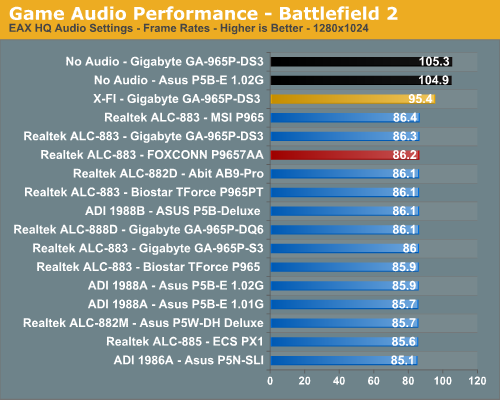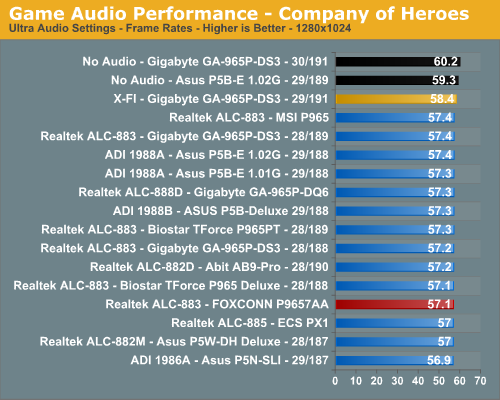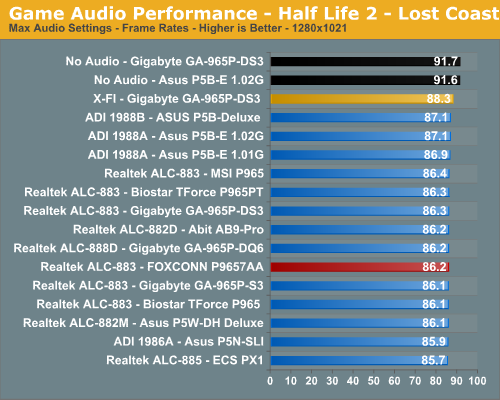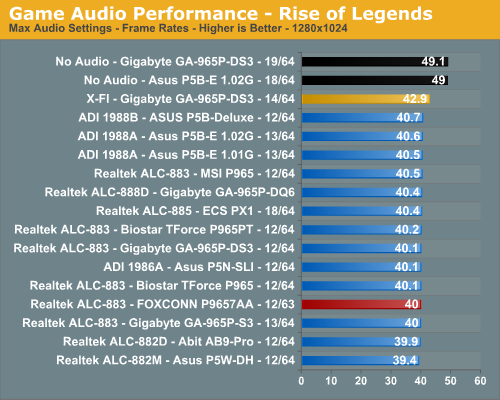Intel P965: Foxconn P9657AA- 8KS2H
by Gary Key on December 28, 2006 7:00 AM EST- Posted in
- Motherboards
Audio Performance
We are no longer showing the individual CPU utilization rates as the use of a dual core processor means the driver load is balanced between each processor with our audio solutions. The 2.3 version of Rightmark properly supports dual core processors but the results are almost meaningless for dual-core users. We have found the CPU utilization rate improvements with the dual-core setup in this test do not have any bearing on actual game benchmarks as the reduction in frame rate percentages are the same as on our single core systems.




The audio performance numbers remain consistent between the Analog Devices and Realtek Codecs but both finish consistently behind the SoundBlaster X-Fi in the benchmarks. This is to be expected as the ADI and Realtek Codecs are host processing units dependent upon the CPU and drivers for generating their audio streams. The SoundBlaster X-Fi on the other hand has dedicated hardware that generates its audio streams and offloads this burden from the CPU. We are finding the CPU utilization rates to be constantly decreasing for the onboard solutions as CPU processing power increases and driver optimizations improve but they still take a toll in certain games. This is reflected in our numbers as Battlefield 2 has an average loss of 22% (was 28%), Half Life 2: Lost Coast at 5%, Company of Heroes at 5%, and Rise of Legends at 22%.
Rise of Legends is a very CPU intensive game with numerous sound effects and as such the CPU hit for generating audio is significant although we did not notice any stuttering during game play. Battlefield 2 utilizes EAX 2 for our ADI and Realtek HD Codecs which creates another significant demand on the CPU to process the audio streams, especially with the sound effects set to high.
Analog Devices has made news lately claiming other host-based audio solutions (Realtek is obviously in their crosshairs) do not properly generate EAX compatible audio in their drivers. After comparing the ADI 1988A to the Realtek ALC-882D in Battlefield 2 we completely agree the issues we heard before are strictly driver related. In fact, the ADI 1988A generated EAX 2 sound effects that were very close or equal to our Audigy 2 and within hearing distance of our X-FI at times.
The audio quality differences in EAX 2.0 capable games between the ADI and Realtek HD Audio Codecs were almost startling. We firmly believe this is due to obstructions and occlusions not being implemented correctly in the Realtek drivers although we did find minor improvements in the latest 1.51 release. In EAX 2 capable games that feature outdoor areas or vast expanses we found sounds at one end of the map to have the same volume and distance correlation as sounds in front of the character. We compared earlier driver releases from Realtek and noticed this issue has become worse over the course of the last year. We suggest turning off EAX 2 in games when utilizing the Realtek solution, as the games will just sound better the majority of time.
The audio differences in other games such as Company of Heroes were minimal although still present. This was especially true in the CoH benchmark where the two American soldiers are treading through the water to meet their group. You could hear the water gently move as they walked while with the Realtek solution the water sounded like a whale coming ashore. This pattern held true for all of our games we tested throughout the benchmark process including thirty games that we tested off-line.
Obviously, if you are a serious gamer, then a dedicated sound card is still useful to ensure consistent frame rates averages across a wide variety of games, and in the case of the Sound Blaster X-FI, you also get improved audio quality and EAX3/4/5 support. If you'd like more details on the Realtek or ADI solutions, you can refer to the Realtek HD Audio Codec Specifications or SoundMAX HD Audio Codec Specifications.
We are no longer showing the individual CPU utilization rates as the use of a dual core processor means the driver load is balanced between each processor with our audio solutions. The 2.3 version of Rightmark properly supports dual core processors but the results are almost meaningless for dual-core users. We have found the CPU utilization rate improvements with the dual-core setup in this test do not have any bearing on actual game benchmarks as the reduction in frame rate percentages are the same as on our single core systems.




The audio performance numbers remain consistent between the Analog Devices and Realtek Codecs but both finish consistently behind the SoundBlaster X-Fi in the benchmarks. This is to be expected as the ADI and Realtek Codecs are host processing units dependent upon the CPU and drivers for generating their audio streams. The SoundBlaster X-Fi on the other hand has dedicated hardware that generates its audio streams and offloads this burden from the CPU. We are finding the CPU utilization rates to be constantly decreasing for the onboard solutions as CPU processing power increases and driver optimizations improve but they still take a toll in certain games. This is reflected in our numbers as Battlefield 2 has an average loss of 22% (was 28%), Half Life 2: Lost Coast at 5%, Company of Heroes at 5%, and Rise of Legends at 22%.
Rise of Legends is a very CPU intensive game with numerous sound effects and as such the CPU hit for generating audio is significant although we did not notice any stuttering during game play. Battlefield 2 utilizes EAX 2 for our ADI and Realtek HD Codecs which creates another significant demand on the CPU to process the audio streams, especially with the sound effects set to high.
Analog Devices has made news lately claiming other host-based audio solutions (Realtek is obviously in their crosshairs) do not properly generate EAX compatible audio in their drivers. After comparing the ADI 1988A to the Realtek ALC-882D in Battlefield 2 we completely agree the issues we heard before are strictly driver related. In fact, the ADI 1988A generated EAX 2 sound effects that were very close or equal to our Audigy 2 and within hearing distance of our X-FI at times.
The audio quality differences in EAX 2.0 capable games between the ADI and Realtek HD Audio Codecs were almost startling. We firmly believe this is due to obstructions and occlusions not being implemented correctly in the Realtek drivers although we did find minor improvements in the latest 1.51 release. In EAX 2 capable games that feature outdoor areas or vast expanses we found sounds at one end of the map to have the same volume and distance correlation as sounds in front of the character. We compared earlier driver releases from Realtek and noticed this issue has become worse over the course of the last year. We suggest turning off EAX 2 in games when utilizing the Realtek solution, as the games will just sound better the majority of time.
The audio differences in other games such as Company of Heroes were minimal although still present. This was especially true in the CoH benchmark where the two American soldiers are treading through the water to meet their group. You could hear the water gently move as they walked while with the Realtek solution the water sounded like a whale coming ashore. This pattern held true for all of our games we tested throughout the benchmark process including thirty games that we tested off-line.
Obviously, if you are a serious gamer, then a dedicated sound card is still useful to ensure consistent frame rates averages across a wide variety of games, and in the case of the Sound Blaster X-FI, you also get improved audio quality and EAX3/4/5 support. If you'd like more details on the Realtek or ADI solutions, you can refer to the Realtek HD Audio Codec Specifications or SoundMAX HD Audio Codec Specifications.










9 Comments
View All Comments
atlr - Friday, April 6, 2007 - link
A P9657AA-8EKRS2H / P9657AA-8KS2H BIOS dated April 5, 2007 has been released.No description about what's different though.
http://www.foxconnchannel.com/EN-US/service/downlo...">http://www.foxconnchannel.com/EN-US/ser...9657AA-8...
Sh0ckwave - Sunday, December 31, 2006 - link
343fsb is crap. no one will buy this for overclocking.ssiu - Thursday, January 11, 2007 - link
Seems like this could be a good option for ultra-budget E4300 overclocking. 9x343FSB = 3.087Ghz is pretty good. Save $30 on motherboard, use stock heatsink and save $$, save some more with cheaper DDR2-667 memory, etc.yyrkoon - Thursday, December 28, 2006 - link
Wouldnt it be nice is manufactures started making mother boards with loads of features, but without all the unnecessary stuff like SLI, dual GbE etc ?Personally, Id like to see a board like the Asus Striker, or ABIT IN9 32x-MAX, that didn't have SLI, and dual GbE. SO in other words, Something along the lines of these types of boards, but with the latest chip sets, eSATA (maybe), loads of disk ports, etc.
BladeVenom - Thursday, December 28, 2006 - link
I'd like to see at least one company make a motherboard with no legacy ports, and no built in audio. Who needs it, and why pay for it if you don't.Beachspree - Friday, December 29, 2006 - link
I'll keep repeating this with each review in the hope of getting a reply. ;-)I was wondering why the Firewire performance is so poor in these reviews:
Firewire 400 gets a best throughput of 230.6Mb/s
It is known that Macs have poor USB 2 performance but look at the Firewire results by Barefeats:
http://www.barefeats.com/usb2.html">http://www.barefeats.com/usb2.html
http://www.barefeats.com/hard70.html">http://www.barefeats.com/hard70.html
Without the perfect conditions of a RAM disk, and without cacheing turned off, they get real world performance of up to:
Firewire 400: 304 Mb/s (31% faster than PC)
Firewire 800: 464 Mb/s (41% faster than PC)
For comparison, Macs are getting lousy USB 2 performance. Intel Macs have improved it but that takes it from around 136Mb/s to 168Mb/s. That's 75% slower.
Given the importance of Firewire in multimedia applications, for which it can be critical, does this poor performance not warrant a mention?
To be clearer:
Can we please have some real world figures for USB 2.0, eSATA and Firewire 400/800 transfers under default settings and off an internal 7200 HDD you standardize on. That's what most people actually do when the backup, so that's what we need to see in order to make informed choices. I suspect these data rates you keep publishing are ones we will actually never see.
I suggest, also, that poor Firewire performance in Windows is more important than poor USB on Macs. They always have Firewire built in and tend to it on peripherals, while Windows users often make do with USB until they get into music or video editing when they then find the need for Firewire and hit this poor performance just when they start needing mission critical performance. I'm talking about dropped frames and music latency.
Why is that ignored in all your motherboard reviews?
Thanks.
SonicIce - Thursday, December 28, 2006 - link
What speakers or headphones do you use to test audio?Orbs - Thursday, December 28, 2006 - link
I have this board in a machine I'm using as a personal server. I paired it with G.Skill F2-6400CL5D-2GBNQ (2 x 1GB of DDR2 800) and it would crash randomly with that ram. After talking to G.Skill, it seems like there is an issue with that ram and all reference-based P965 boards including this board.Memtest86 also failed test #5 consistently with this ram on this board.
G.Skill is sending me replacement ram (their F2-6400PHU2-2GBNR) which should be here next week. Hopefully it's more stable.
Orbs - Thursday, December 28, 2006 - link
Just to be clear, I'm not saying this board or Foxconn is at fault for the compatibility issues, I'm just noting my experience so others don't run into the same problem.